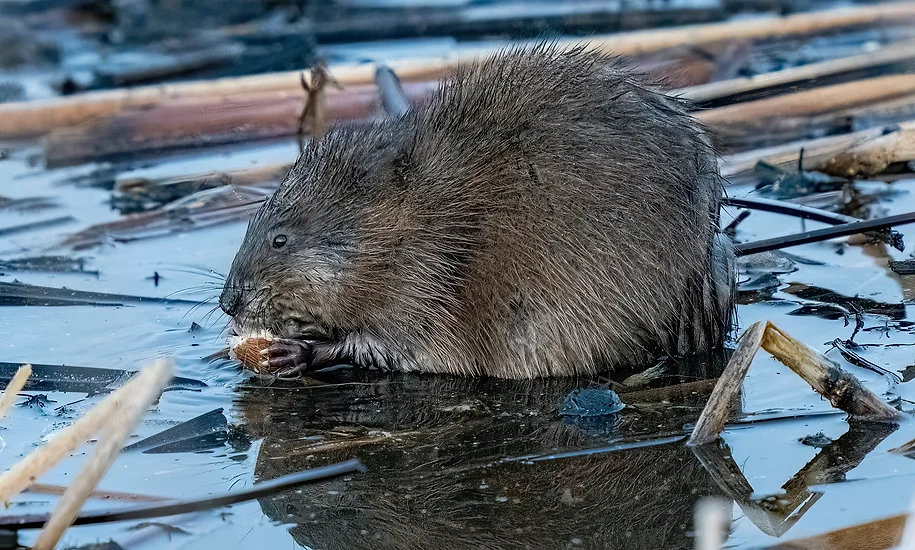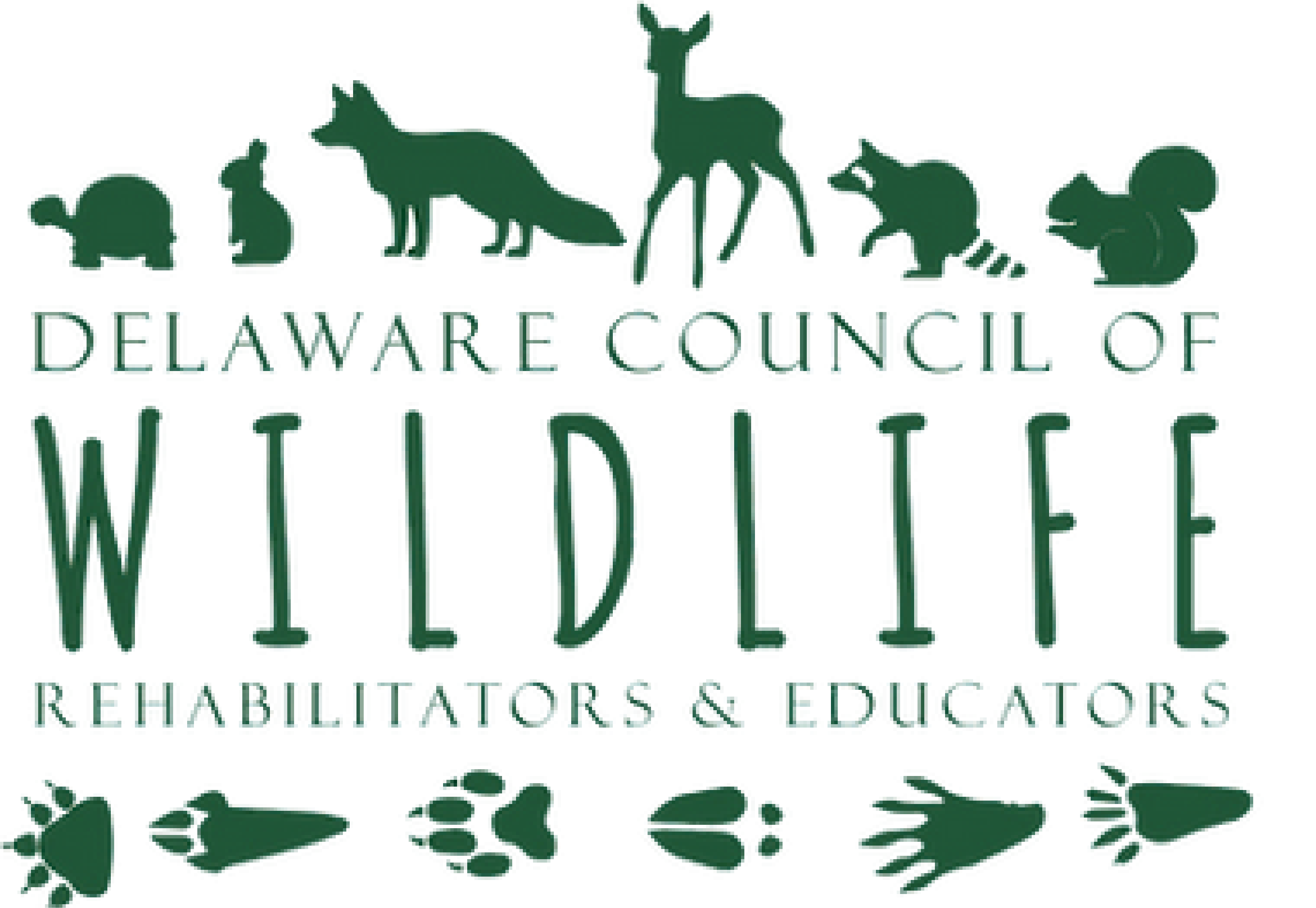Beaver (Castor canadensis)
Rehab Criteria: Young beavers found without an adult most likely need assistance.
*Potential to carry rabies.
Do not handle beaver with bare hands as the rabies virus can enter a cut or open wound on your skin. This can also result in the animal(s) being euthanized and tested for rabies.
When rescuing small wild animals, it’s a good idea to wear gloves. Be aware, however, that gloves provide only a small amount of protection, and that most mammals can easily bite through them. Raccoons, skunks, bats and some foxes are more likely than other mammals to carry rabies, but any wild animal may carry the disease. There are a number of other serious or fatal diseases that can be transmitted to humans, so you must take care that the animal doesn’t bite you.
Physical Characteristics: large rodent, that has waterproof, rich, glossy, reddish brown or blackish brown fur. Small ears, large front teeth, and a leathery paddle like tail. Possess webbed toes.
30 to 60 pounds
30 to 40 inches in length
Lifespan: 10 – 20 years
Habitat: semi-aquatic: live in ponds, lakes, rivers, and streams. Particularly in woody areas. Beavers live in lodges built on the banks of ponds and lakes. The lodge is an oven-shaped house of sticks, grass, and moss, woven together and plastered with mud.
Diet: Tree bark and leaves; also eats bay grasses and the roots and rhizomes of aquatic plants.
Family Life: Beavers are monogamous and live in colonies which make up one male and one female mating pair. Mating season take place in January and February. In early summer young are born. Beavers on average have 2-4 young a year. Young are weaned at 2 to 3 months old, but do not usually leave the colony until they two to three years old when they are driven out by the adult pair.
Predators: Adult beavers have few natural predators, but young beavers may be preyed on by owls, hawks, and otters.
Other significant threats: humans and habitat loss
Special considerations/Interesting facts: Beavers are the largest rodent in North America. Beavers maintain wetlands that can slow the flow of floodwaters. They prevent erosion, and they raise the water table, which acts as a purifying system for the water. This happens because silt occurs upstream from dams, and toxins are then broken down. Beavers are primarily nocturnal. They are only occasionally seen during the day, usually around dusk.

Muskrat (Ondatra zibethicus)
Rehab Criteria: Inactive young found outside the lodge may need intervention.
When rescuing small wild animals, it’s a good idea to wear gloves. Be aware, however, that gloves provide only a small amount of protection, and that most mammals can easily bite through them. Raccoons, skunks, bats and some foxes are more likely than other mammals to carry rabies, but any wild animal may carry the disease. There are a number of other serious or fatal diseases that can be transmitted to humans, so you must take care that the animal doesn’t bite you.
Physical Characteristics: Medium size semi-aquatic rodents with brown fur and a paler color of fur usually along their underside. Muskrats are much smaller than beavers, and while they do possess a long scaly tail, it is not as wide or flat as a beaver’s tail, and looks more like a narrow rudder. Muskrats have partially webbed feet.
1 to 4 pounds
16 – 28 inches in length
Lifespan: 3-4 years
Habitat: Primarily in marshes but can also lives in other types of wetlands such as swamps, ponds, lakes, streams, and rivers.
Diet: Mainly vegetarian feeding on roots and rhizomes of marsh plants. However, they will also eat fish, frogs, insects, and shellfish.
Family Life: Muskrats breed throughout the year, having roughly 1 to 3 litters per year. Each litter produces on average 5-6 young. Muskrat young can swim withing 10 days from birth, and within 21 days they can eat plants. After one month, the independent young leave the lodge. Muskrats live in large family groups and only disperse when conditions become overcrowded.
Predators: minks, raccoons, otters, coyotes, owls, hawks, red foxes, and bald eagles.
Other significant threats: humans
Special considerations/Interesting facts: Communicate using smells from a musk gland, hence the name muskrat. Muskrats prefer shallow areas with 4 to 6 feet of water and similar to beavers they build and live in semi-aquatic lodges made of sticks, mud, and brush. Muskrats possess poor vision, hearing, and smell; however, they are excellent swimmer and use this to escape predators. Muskrats have been known to stay submerged for up to 17 minutes at a time. Many other animals including turtles, snakes, and Canadian Geese use the tops of their lodges as habitat or nesting sites.
Northern River Otter (Lontra canadensis)
Rehab Criteria: Young otters found alone or without an adult need help. When rescuing small wild animals, it’s a good idea to wear gloves. Be aware, however, that gloves provide only a small amount of protection, and that most mammals can easily bite through them. Raccoons, skunks, bats and some foxes are more likely than other mammals to carry rabies, but any wild animal may carry the disease. There are a number of other serious or fatal diseases that can be transmitted to humans, so you must take care that the animal doesn’t bite you.
Physical Characteristics: Semi-aquatic mammals, with long, streamlined bodies, thick tapered tails, and short legs. They have wide, rounded heads and small ears. River otters have dense fur which is usually a deep brown while their throat and belly are golden or silvery brown. They possess webbed feet.
35 to 50 inches long from nose to tail
11 to 30 pounds
Lifespan: 8-9 years
Habitat: Live in freshwater and coastal marine habitats, including rivers, lakes, marshes, swamps, and estuaries. River Otters build dens in the burrows of other mammals, in natural hollows, such as under a log, or in riverbanks.
Diet: Main food source is fish; but will also eat frogs, crabs, crayfish, and small mammals.
Family Life: Breeding occurs in late winter and early spring, and offspring will be born usually two months later. Litters consist of usually 1-4 young. At one month old offspring open their eyes, at 3 months old they are weaned, and at 6 months to 1 year old they leave the den. River otters are somewhat territorial and often avoid each other except during the breeding season, and only living in small family groups or same-sex groups when they do live together.
Predators: coyotes, large birds of prey, and some larger animals such as bobcats and alligators in other habitats.
Other significant threats: Humans, habitat loss, and habitat decline in the form of pollution.
Special considerations/Interesting facts: River otters may travel several miles over land to another stream or lake. Unlike sea otters, river otters do not float on their backs. River otters can close their nostrils for long underwater swims. River otters have a low tolerance for polluted water and are considered by some naturalists to be a good indicator, or "keystone" species of the quality of aquatic habitats.
